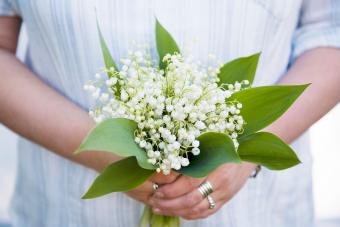
You know what we love the most about March? The arrival of spring flowers! And two of the earliest are daffodils and jonquils, which burst forth in late winter or early spring with sunny colors that serve as a harbinger of the wonders of the season yet to come.
So it's probably no surprise, then, that if you're a March baby, these two beauties are your birth flowers. Just like you, they bring a little sunshine into the world after a long winter. Here's everything you need to know about these pretty, springy birth flowers.
Daffodils Make Great Cut Flowers

Daffodils make pretty, showy spring cut-flower bouquets. Because they have a sap that can be toxic to other flowers, it's best to keep them in bouquets by themselves.
Daffodils Come From Fall-Planted Bulbs
If you're looking for pops of sunny color in your late winter or early spring garden, plant your daffodil bulbs in the fall. They need to overwinter under frost in order to develop properly. They're perennials, so they'll come up year after year.
Daffodils Need Full Sun to Partial Shade
While daffodils would look pretty around the base of a super shady tree, it's not the best environment for them. They thrive in partial shade to full sun because they need at least six hours of direct sunlight every day.
Daffodils Symbolize New Beginnings
As some of the earliest flowers in late winter or early spring, daffodils embody spring and represent new beginnings and hope. Their sunny yellow color also symbolizes joy, and the flowers are considered good luck.
Daffodils Are Toxic to Pets
Keep children and pets away from daffodils (and jonquils). All parts of the plants are toxic to children and pets. So if you have plant-eating pets, you may want to put daffodil bouquets up high — or skip them altogether if you have cats that are climbers.
You'll Find Daffodils in Mythology
Narcissus, the son of a nymph and river god, was famous for his stunning good looks and said to be a beauty. However, he brought the wrath of the gods on him when he rejected the nymph Echo. The gods made him fall in love with his own reflection in the river. There are several versions of his fate. One states that Narcissus pined away for his reflection until he died. Another version states his angst over his longing for himself ended with him committing suicide. The flower that grew out of the ground where he died bears his name, narcissus, more commonly known as daffodil.
Jonquils Are Technically Daffodils

The jonquil is a narcissus and technically a daffodil, so they grow like daffodils. All jonquils are daffodils, but not all daffodils are jonquils.
Jonquils Are Small Daffodils
Jonquils are a specific type of daffodil (Narcissus jonquilla). Jonquils are smaller and shorter than common daffodils. The jonquil leaves are usually round, and the stems are similar to a reed. Common daffodils typically have just one large blossom at the end of the stalk, but jonquils have several small ones. Some jonquils can have as many as eight flowers per stalk.
Related: March Birthstones: Bloodstone & Mysterious Aquamarine
Jonquils Grow Best in the South
Jonquils prefer the hot, humid climate of the Southern region of the United States and can tolerate very hot environments.
Jonquils Have a Strong Perfume
Common daffodils don't have much of a scent/aroma, but jonquils have a strong, pleasant floral perfume.
Jonquils Symbolize Forgiveness
Because they're daffodils, you can use jonquils to represent similar sentiments to common daffodils. But they go a step further, representing forgiveness, too. If you're feeling bold, you can also give jonquils to a crush to represent that you hope they reciprocate your feelings.
Sunny Yellow March Birth Flowers
The differences in the two flowers for a March birth flower are subtle when you compare daffodils and jonquils. No matter where you live, you'll probably find one or both of these pretty fall bulbs growing right around your birthday every year.







